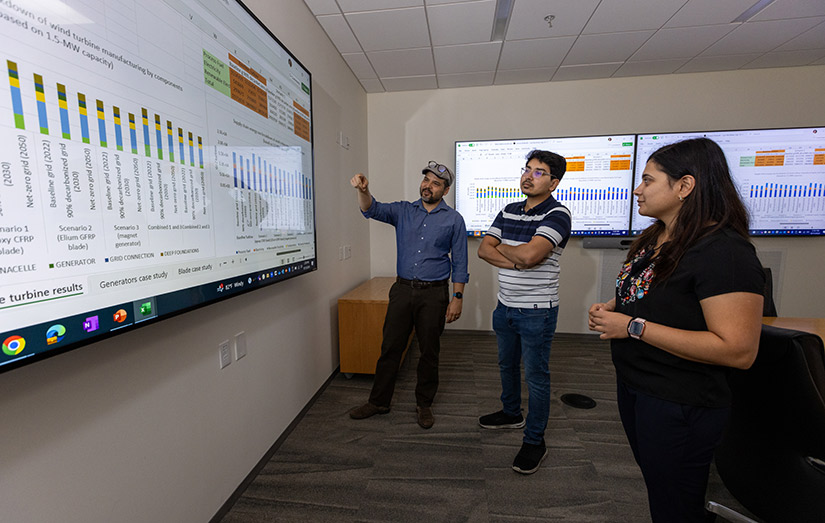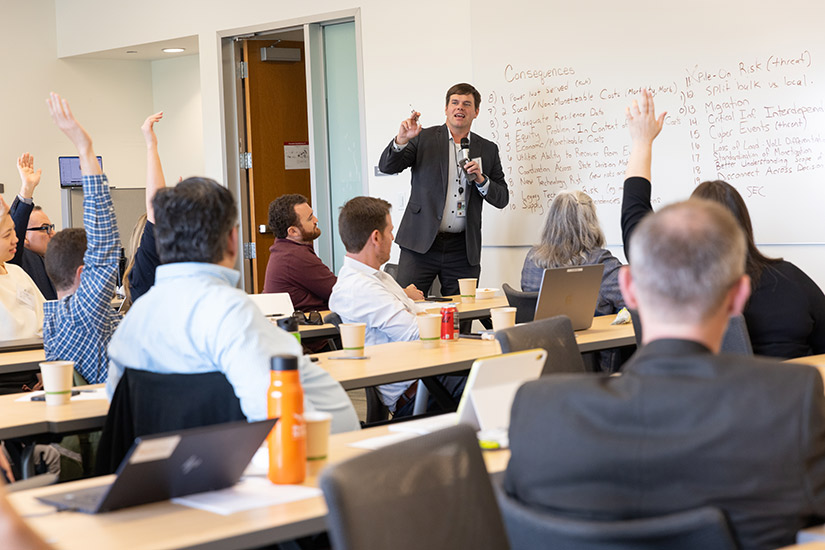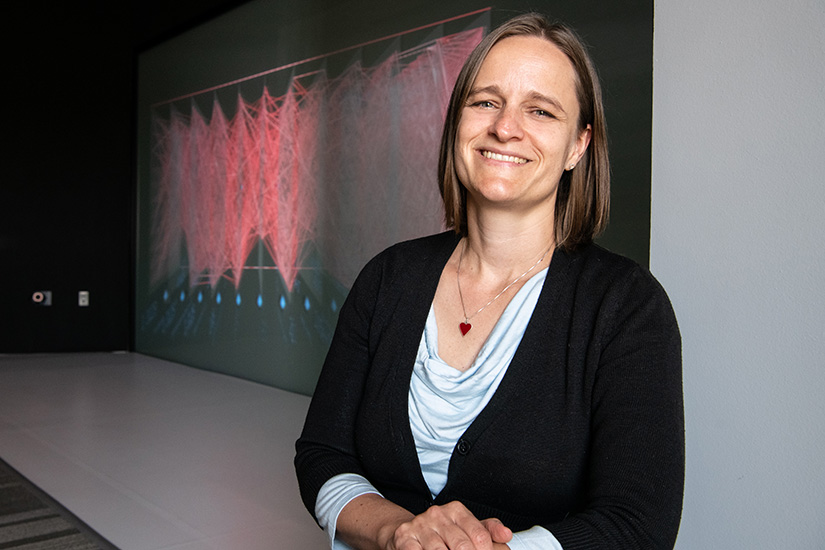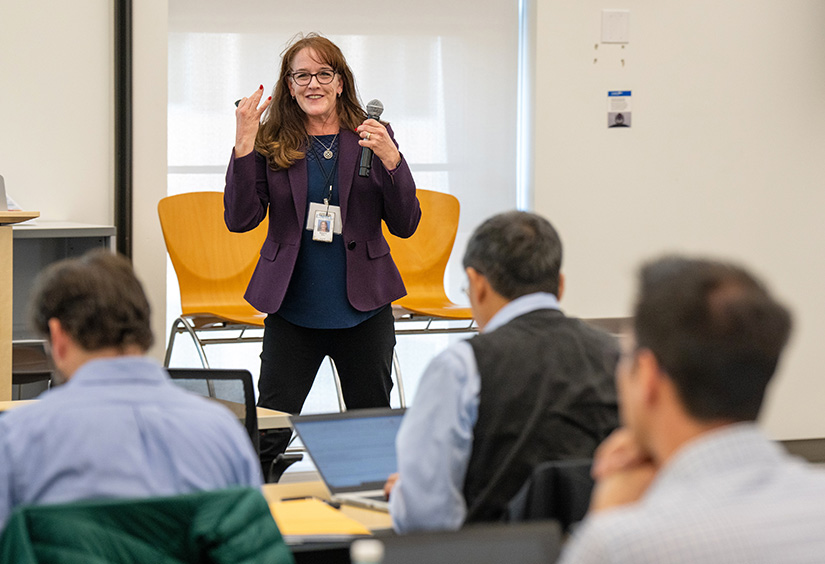Biofuels and Batteries Gain From the System Dynamics Behind the Research
How Modeling Feedback Loops Informs Analysis and Decisions Across Decarbonization Technologies

"When you look at renewable energy, not everything is linear," said Swaroop Atnoorkar, an analyst at the U.S. Department of Energy's (DOE's) National Renewable Energy Laboratory (NREL). "Technologies often operate in complex systems with many moving parts in the background."
Atnoorkar relies on understanding the intricacies of clean energy systems in her research on biofuel economics and supply chains. Research like hers is a vital step in understanding how each decision made with any given technology could impact its evolution.
But how do researchers examine the relationships between various factors within a given system, how they could change, and how those changes ultimately lead to different behaviors in the system over longer periods of time? And what exactly does this type of research inform?
The answers to those questions may lie within a sophisticated modeling method known as system dynamics.
Brief History of System Dynamics
Since its creation in the 1950s by Jay W. Forrester, a professor at Massachusetts Institute of Technology, system dynamics has become a tried-and-true method for understanding the behaviors of complex systems in terms of stocks, flows, and the feedback loops that connect them.
A simplified and generic example of a system dynamics model illustrates the complex interactions that could occur within a biofuel supply and production chain, featuring a feedstock, conversion pathway, and biofuel supply module. Graphic by Liz Craig, NREL
Think of this relationship like planting crops such as corn. The growth of corn in the field—a flow—is controlled by feedback processes including watering and nutrient availability. When the stock of corn is harvested, other feedback loops control the decomposition of residues and the return of nutrients to the soil.
At the time Forrester developed it, system dynamics research was applied to corporate managerial questions at General Electric's plants. Studying corporate managerial problems remained its primary application through the 1960s, until researchers broadened its uses to examine other larger-scale societal questions. Initially, these simulations of stock-flow feedback structures were conducted with command-line programs, visualized with hand-drawn diagrams, and showed how internal management decisions impacted the dynamics of inventory and human resource systems. Now, its applications include examining everything from public health to renewable energy systems.
"Many of the early users of system dynamics knew its potential was far greater than its original business management use," said Bobby Jeffers, acting laboratory program manager in NREL's Energy Systems Integration directorate. "We are always trying to answer the question: ‘What are the feedback loops that really take hold of the system and cause it to go on some trajectory?' We're trying to encourage virtuous cycles that build on themselves while finding dampening cycles that allow things to grow sustainably."
Jeffers specializes in system dynamics research. He and other researchers at NREL, like Atnoorkar, now use computer modeling to explore the complex relationships between various elements of system structures.

Snapshot of System Dynamics at NREL
Atnoorkar is among the newer members of the research team working to find new ways to approach biofuel development at NREL.
For the last decade, much of the work being done to gain insights into the biofuel market has utilized NREL's Bioenergy Scenario Model (BSM), which is funded by the U.S. Department of Energy's (DOE's) Bioenergy Technologies Office (BETO). The System Dynamics Society Award-winning model tracks biofuel deployment and the effects of various influences on the biofuel market, such as changes in consumer demand, government policies, and land availability for feedstock. It dynamically models these elements as part of the U.S. domestic biofuels supply chain.
"Factors like oil prices, biofuel demand, and the costs of resources are always fluctuating—sometimes unpredictably—and changes in each one creates different outcomes, especially at the national scale," Atnoorkar said.
NREL and BETO have historically used BSM to develop deployment strategies for advanced biofuels. Currently, it helps researchers like Atnoorkar develop insights into U.S. biofuels market growth and examine potential barriers to broader expansion of biofuel technologies. Among those technologies are those that create sustainable aviation fuels.

System dynamics research at NREL helps inform development and policies surrounding sustainable aviation fuel that is used at airports across the United States. Photo from Getty Images
"Many airports nowadays have sustainability goals, and they want to determine if those goals are feasible," Atnoorkar said. "While the BSM does analysis for potential biofuels supply at the national scale, the analysis we do at the regional scale can also help ports and airports make decisions about their biofuel sourcing."
To that end, the system dynamics research being done at NREL has ultimately helped inform policy strategies surrounding low-carbon fuel standards. A major part of that research is the Sustainable Aviation Fuel (SAF) Grand Challenge—a plan set forth by DOE, the U.S. Department of Agriculture, U.S. Department of Transportation, and other federal agencies that aims to spur the expansion of commercial SAF production technologies.
Critically, the SAF Grand Challenge is targeting at least a 50% reduction in life-cycle greenhouse gas emissions and ramping up SAF supply to meet 100% of aviation fuel demand by 2050.
"The BSM is now being used to investigate how we could reach those goals and what kinds of roadblocks may need to be overcome," said Emily Newes, the NREL Strategic Energy Analysis Center's Integrated Modeling and Economic Analysis Group manager.

Newes works extensively with the system dynamics models informing potential biofuel deployment, specifically the SAF Grand Challenge and biofuels for maritime applications. These models are answering questions about how changes in everything from the resources needed to build refineries to the different types of potential feedstocks ultimately affect the policies and decisions being made.
"It helps inform us about what barriers there could be so that we can help find solutions—either through policy or the industry—to overcome them," Newes said.
System dynamics models are also informing NREL's research in battery energy storage. A key modeling framework used in this space is the Lithium-Ion Battery Resource Assessment, or LIBRA, model. LIBRA is vital in NREL's work in understanding the supply chain of lithium-ion batteries, which have become a key component to a future with more electric vehicles (EVs) on the road.
"When we're talking about the needs for manufacturing in this country and globally, you can't just look at one technology at a time," NREL's supply chain analytics lead Maggie Mann said. "When we talk about batteries, we're looking at how much cobalt, nickel, and lithium are needed to manufacture them, as well as the demand for those same materials for other technologies."

Mann was on the team that pioneered and developed the LIBRA model. It gives users the means to examine the long-term effects of changes in the battery supply chain for multiple EV battery types, consumer electronics, and utility-scale storage systems.
Through examining elements such as the costs, raw materials, and changing policies at both the domestic and international scales, LIBRA is providing invaluable insights into the U.S. battery recycling supply chain. Those insights then inform manufacturing and industry practices as well as policy decisions in the clean energy sector.
Along with the LIBRA model, supply chain researchers at NREL, like Mann, are also developing the Recursive Integrated Networks for Growth (RING) model, which supports NREL's Mapping, Modeling, and Analysis Consortium (MMAC). This model, designed specifically for DOE's Manufacturing and Energy Supply Chains (MESC) office, calculates how each output can be cycled back into the supply chain itself. What does that mean?
"Say you want to look at how many batteries are manufactured, then go through their life, hit the end of their life, and you want to recycle them, so the raw materials and battery components go back into manufacturing," Mann said. "System dynamics can allow for those types of recursive calculations and help us look out 10 to 12 years to see the total demand for manufactured batteries minus the raw materials that are recycled."
Both the RING and LIBRA models help researchers answer the critical question of "How much could recycling batteries affect the amount of new material we need to produce?" Each model helps inform the decisions behind battery production and policies through 2050 and quantify the impact that recycling can have on decreasing the United States' dependence on foreign resources.

How Is System Dynamics Evolving at NREL?
Much of the research Atnoorkar, Jeffers, Mann, Newes, and others do in supply chains is centered around system dynamics. Because of their broad lenses, models like BSM, LIBRA, and RING are often used to develop strategies for new technology deployment.
In the case of BSM, bioenergy's large, comprehensive nature makes it tougher to focus on smaller-scale system dynamics. That is why the team is working to modify it for limited-case, regional scenarios, using a new BETO-funded model called the Regional Bio-Economy Model (RBEM).
"The main structure is the same," Atnoorkar said. "But with RBEM, we are able to focus on biorefinery investment decisions in specific regions, such as marine biofuel production in coastal areas or aviation biofuel production in the immediate area around a major airport."
RBEM will enable researchers to examine the logic behind the feedback loops in those smaller systems. The team aims to publicly release this model in the next year or two.
And while Atnoorkar and Newes are helping with the development of RBEM, Jeffers says NREL could look to system dynamics as a unique lens to broaden the scope of NREL's research into a low-carbon energy system future.
"I think we lead the world in showing what a decarbonized energy system could look like," Jeffers said. "But system dynamics can help us realize this future by giving us a means to think about all the complex elements of economic, social, and environmental systems that influence the pathway to affordable, resilient, and secure decarbonization."
Explore NREL's bioenergy, energy analysis, and grid modernization research.
Last Updated May 28, 2025
